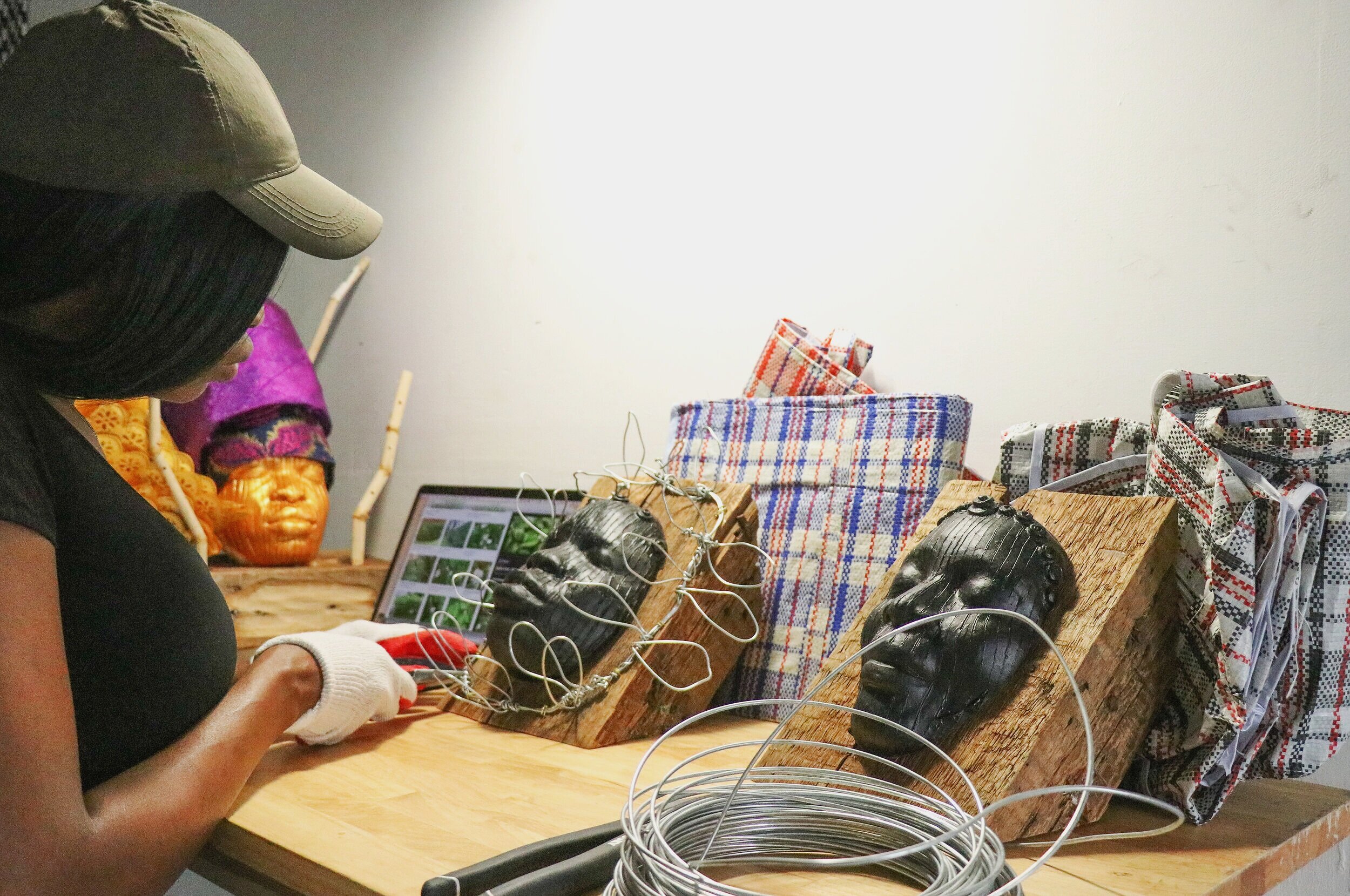Storm Ascher: Where are you currently? Do you have access to a studio set up during quarantine?
Layo Bright: I’m in Long Island City, New York, in my shared living space. Half of my room is a makeshift studio, where I keep my sculptures and materials. I just learned screen printing, and have a separate space in the apartment where I work on that.
Storm Ascher: What to you makes a “successful” sculpture?
Layo Bright: Success is relative. I don’t think of comparative ways of assessing my works when I’m making them. Instead, it’s a kind of dance with each work — the ‘dance’ here connoting free thought and expression — it doesn’t have to be perfect but I make my own moves and enjoy what each one brings. If I don’t let myself ‘dance’ freely, then it’s back to the start for me.
Storm Ascher: When casting your own face in your sculptures, can you talk about that process? Set time, how long are you in the alginate? Do you have a mold that you reuse?
Abelmoschus esculentus (Okra), 2020
Abelmoschus esculentus (Okra), 2020 (verso)
Layo Bright: I work with a mother mold mostly, but make variations and additions to create new molds (especially with glass works).
Storm Ascher: What thoughts run through your head during casting?
Layo Bright: I can’t pinpoint that. It’s more like white noise — I’m usually listening to one song on repeat for hours when I’m working so I can settle into a flow state — to let myself instinctively ‘feel’ my way through the process
Storm Ascher: Do you see the busts that you are making as formal sculptures, plants, idols, totems, an altar? Is it a self portrait?
Layo Bright: They are and then they aren’t. It’s one thing for me to make the works, but they take on their own agency. Though based on my likeness, the scarification, head dress and flora/fauna start to shift it away to different realm. One of history, cultural legacy, identity and imagination.
Storm Ascher: Your use of textiles and softer materials to embellish your busts have a painterly quality to them, do you paint or draw these out first?
Layo Bright: I don’t draw, sketch or paint my sculptures beforehand. I like to sit with the materials and individual components of the sculpture. Then I observe, touch and think about each material and what it signifies. With the gele sculptures, I think of my mother and how she has worn each gele to various occasions (weddings, church, funerals, family celebrations, etc.) Then I build from the base up.
Storm Ascher: What techniques do you use to combine both hard and soft sculptural materials into a cohesive piece?
Layo Bright: Intuition — I reach for what feels essential or important to me in the work. Occasionally I have come to a point where the materials seem like polar opposites, but rhyme together really well once brought together. It’s exciting to discover as I create. I keep an open mind to materials around me and trust my judgment to experiment.
Checkered: Red on Blue, 2020 Screenprint on paper Edition of 5 + 1 AP 14 x 20 in
Checkered: Blue on Yellow, 2020 Screenprint on paper Edition of 5 + 2 AP 14 x 20 in
Checkered: Orange on Purple, 2020 Screenprint on paper Edition of 10 + 1 AP 14 x 20 in
Storm Ascher: Are you always sourcing more Ghana Must Go bags as material for each new project? What is the level of access to this material? Is the pattern commonly used still in Nigeria or is it seen as offensive (sort of like we see the confederate flag)?
Layo Bright: I get them from various parts of New York where I’m based (Harlem, Bushwick, Queens, etc.), and I sometimes get them sent to me from Lagos (Nigeria). Some are the common red/blue/black, others are quite colorful and have patterns. The moniker “Ghana Must Go bag” is widely and commonly used, and is still known by that name in Nigeria. Globally, the bags are usually named after a predominantly immigrant demographic in an area and I explore the xenophobic histories that it often connotes e.g. Ghana Must Go bags’ in parts of West Africa, ‘Shangaan or Zimbabwe bags’ in South Africa, ‘Türken Koffer’ in Germany, etc.
Storm Ascher: What the most recent conversation you had that changed an aspect of your art practice?
Layo Bright: “Don’t overthink it. Just make what comes to you.”
Storm Ascher: What books are you reading right now?
Layo Bright: Drive by Daniel H. Pink - on the truth about what motivates us and Kiriji Centenary (1886 - 1986) edited by Dr. G. O. Ekemode - a book on the Kiriji war and my great great grandfather’s heroic efforts in the war.






